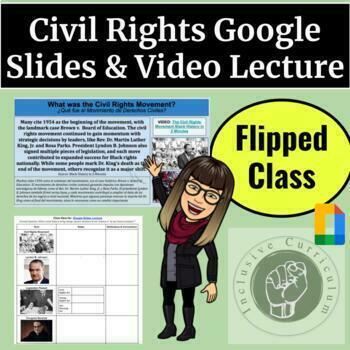Civil Rights Movement Flipped Class Google Slides & Video Lecture
- Google Slides™

Description
This is a Civil Rights Google Slides Lecture, but instead of the teacher lecturing, every slide has a video to explain the vocabulary term being covered. Why lecture in your U.S. History class when instead you can play interesting videos? The truth is most students do not learn best by their teacher lecturing for a whole period. Most students would rather learn by watching videos and discussing and reflecting what they are learning with their peers. This is a google slides presentation that includes definitions, videos, and guided notes with pictures to teach students about the Civil Rights movement. You can play the videos for your students, or assign them as a class activity to have students watch on their own. This activity ends with students researching the demographics of their own school and discussing whether it is considered segregated.
Essential Question: What is more likely to bring change: passive resistance & non-violence or “by any means necessary”?
Perfect for a flipped classroom! And for those who want to create a more inclusive curriculum.
This is a google document so feel free to edit as you see fit.
Great for English Language Learners!
-All slides have Spanish translations for Spanish speakers (using google translate).
Inclusive Curriculum! Covers:
- Black Civil Rights Movement
- American Indian Civil Rights Movement
- Asian American Pacific Islander Civil Rights Movement
- LGBTQ Civil Rights Movement
- Farmworkers Civil Rights Movement
Includes:
- Google Slides with vocabulary definitions
- Video link for every vocabulary word (27 video links included)
- Graphic Organizer with photos for English Language Learners
- 6 Primary Sources Included
- Reflection
Vocabulary Covered:
Civil Rights Movement
Civil Rights Act
Voting Rights Act
Fair Housing Act
Thurgood Marshall
Brown V. Board of Education
Passive Resistance or Any Means Necessary
Rosa Parks
Martin Luther King Jr.
Letter from a Birmingham Jail
Montgomery Bus Boycott
Little Rock Nine
Freedom Rides
Emmett Till
Black Power, Stokely Carmichael, and the Black Panthers
Malcolm X
A.I.M. Native American Civil Rights Movement
Cesar Chavez and the United Farmworkers Movement
Vincent Chen and Asian American Civil Rights
Harvey Milk and Gay Rights
CA History Framework Standards Covered:
11.10 Students analyze the development of federal civil rights and voting rights.
4. Examine the roles of civil rights advocates (e.g., A. Philip Randolph, Martin Luther King, Jr., Malcom X, Thurgood Marshall, James Farmer, Rosa Parks), including the significance of Martin Luther King, Jr.’s “Letter from Birmingham Jail” and “I Have a Dream” speech.
5. Discuss the diffusion of the civil rights movement of African Americans from the churches of the rural South and the urban North, including the resistance to racial desegregation in Little Rock and Birmingham, and how the advances influenced the agendas, strategies, and effectiveness of the quests of American Indians, Asian Americans, and Hispanic Americans for civil rights and equal opportunities.
6. Analyze the passage and effects of civil rights and voting rights legislation (e.g., 1964 Civil Rights Act, Voting Rights Act of 1965) with an emphasis on equality of access to education and to the political process.


